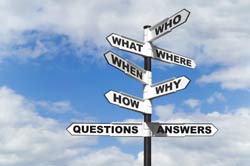|
Take Courage!
Fear is a Given
“It’s not my first rodeo,” remarked Jeanie, a client who is preparing to move cross country and pursue a new career path. She is familiar with the voices of fear from the peanut gallery. Some are from friends who ask, “Are you sure about this?” while other doubtful refrains originate in her own mind. Fortunately, Jeanie has made big moves before and is prepared for this stage of second-guessing her decision. She knows how to keep the fears in perspective by talking back to them: I know this is right for me.
Notably, “Be not afraid,” is a command that appears throughout the Bible many times. The implication is that we have the power to choose even though it doesn’t feel that way when in the grip of fear. I once heard it suggested that a better interpretation is: Do not remain afraid. Now that seems more doable. Since fear is a given in life, it’s vital to remember that courage is a decision, sometimes a stubborn assertion, and always an act of will.
As with so many other uncomfortable emotions, rather than expecting to eradicate fear before proceeding, we only need to know how to diffuse it. There is a coaching aphorism: Fear may be in the car, but it doesn’t have to be driving.
Who’s Driving The Car?
 Here are some ways to interact with fear and coax it into the back seat: Here are some ways to interact with fear and coax it into the back seat:
Anything helpful here?
For as obnoxious as its delivery can be, fear often brings important information to the surface. When my client Danielle was getting ready for a job interview, the fear of possibly having to take a salary cut was nagging her. Rather than allowing the fear to fester, Danielle turned it into something helpful by: 1) clarifying her acceptable salary range instead of keeping this vague in her mind and 2) rehearsing how she would respond to salary questions. Check to see if your fear is bringing out anything valid or useful; otherwise, frame it as just noise.
Attention: You Are Now Leaving Your Comfort Zone!
Fear is often an indicator that you’re stepping out of the predictable and are ready for something more. When you acknowledge fear as part of the growth process it actually becomes a positive sign.
So What?
A game we use in the Now What?® program¹ is to name your fear and, in a playful way, have a partner keep asking you “So What?” or “And then what?” until your fear runs out of steam. Usually this culminates in laughter when you follow your fear to its ridiculous end. What typically becomes evident is that you would be willing and able to handle what comes up well in advance of the worst case scenario actually materializing.
Visit, Don’t Stay.
Rather than denying it, recognizing and naming your fear gives it less power. Just be sure it’s a visit and not a long stay. Since fear comes along with vivid details of what awful thing might transpire, use the same creativity to imagine what you would like to have happen. Spend more time there.
Flip the Coin.
At any new juncture, those nervous butterflies will appear on cue, yet the other side of fear is wonder and anticipation. As the saying goes, “Fear is excitement without breath.”² Breathe through your fear to see the other side of this coin.
Take The Keys!
 What frightens us in life these days? So very many things. Remember that you are much more than any momentary feeling. The expression “take courage” reminds us that you cannot wait to feel courageous; you must go ahead and take courage. What frightens us in life these days? So very many things. Remember that you are much more than any momentary feeling. The expression “take courage” reminds us that you cannot wait to feel courageous; you must go ahead and take courage.
This Week’s Call to Action: When you think of the situation before you or the desire that you hold deeply, what frightens you most? Ask yourself:
- What am I afraid of?
- What might actually be good about this fear I’m feeling? What does it tell me?
- What within me is stronger than my fear?
“Courage is resistance to fear, mastery of fear, not absence of fear.”
— Mark Twain
Here's to you,

Notes:
¹Now What?® is a registered trademark of Laura Berman Fortgang. Learn more about the program here.
²The saying “Fear is excitement without breath,” is attributed to Fritz Perls, the founder of Gestalt therapy.
See Also: Trusting Your Clarity
|

 Here are some ways to interact with fear and coax it into the back seat:
Here are some ways to interact with fear and coax it into the back seat: What frightens us in life these days? So very many things. Remember that you are much more than any momentary feeling. The expression “take courage” reminds us that you cannot wait to feel courageous; you must go ahead and take courage.
What frightens us in life these days? So very many things. Remember that you are much more than any momentary feeling. The expression “take courage” reminds us that you cannot wait to feel courageous; you must go ahead and take courage.